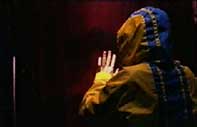Room Scene
Though he tries - by clicking at the screen - to continue his search for experience, P is unable to become immersed in the screen once more, and finds himself confined to his room.
He looks around for the source of this disruption, and sees the torn fragments of his photographs strewn on the floor. This draws his eye to the window - its curtains open. When he catches a brief glimpse of his reflection, he panics and quickly draws the curtain.

A screenshot from the room scene
After pausing to catch his breath (shown above), he turns to examine the room, sensing that all is not well.
The room is sparsely lit, and its walls seem to be made out of the darkness. He notices the hanging mirror, and approaches it, but after catching sight of his hand, he understands that the mirror must also be covered, since it might supply him with another false and distorted image of himself. In its reflection he sees the sofa, walks towards it and picks up a piece of material that is draped over one arm.
As a result of this functionality, viewers create their own edit of the film, as if HyperFilm were the video equivalent of a musical instrument. Inadvertently too, they also shape the narrative, since, in any single viewing, only half of the footage is ever seen.
About This Page
HyperFilm is a prototype interactive film that I made way back in 1997. If you already have a copy of the film on CDROM, you can use this production file to find out more about the film. If you would like a copy, please email me. You can leave comments on the blog entry which refers to this project.
